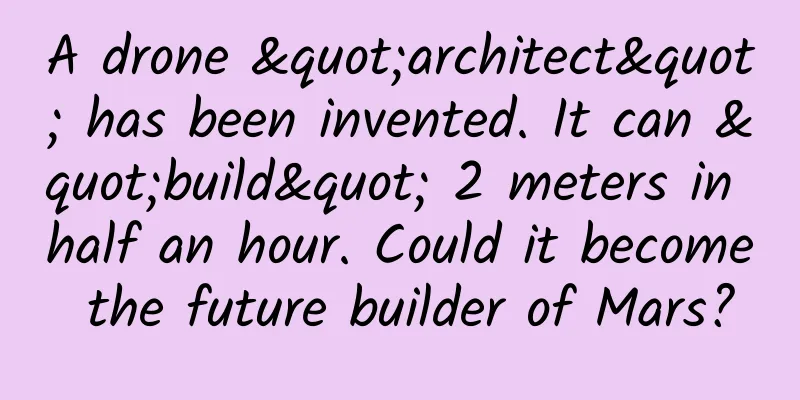A drone "architect" has been invented. It can "build" 2 meters in half an hour. Could it become the future builder of Mars?

|
As humans greedily transform the Earth, their dream of Mars becomes stronger. Since the 1960s, humans have carried out more than 40 exploration missions to Mars, but have not yet sent anyone to Mars. In March this year, Musk, who is highly expected, claimed that he hopes to send humans to Mars in 2029. (Previously, the planned dates were 2025 and 2026.) However, even if humans are eventually able to land on Mars, the harsh environment, such as the thin atmosphere, cold climate, and widespread dust, will make it difficult for humans to move and work on the surface of Mars for a long time, such as building human residences and activity sites under the extreme conditions on Mars. Today, a research team from Imperial College London, the Swiss Federal Laboratories for Materials Science and Technology (Empa) and their collaborators have provided a new possibility for future construction on Mars. Inspired by bees , they proposed a new construction method, which is to use drones to build 3D printed structures in flight, helping humans to build any building anywhere on or off the earth. Figure | Concept map of Mars construction. (Source: Research team) It is reported that these 3D printing drone swarms are composed of BuilDrone (construction drone) and ScanDrone (scanning drone). The former places construction materials on the surface of the building during flight, while the latter is mainly responsible for quality control tasks, measuring the construction status of the former during flight and giving suggestions for the next construction. Most importantly, these drone "architects" can build 3D structures in groups under human supervision. This major achievement was published today as a cover article in the latest issue of Nature magazine. Image: Cover of the latest issue of Nature. (Source: Nature) In this regard, Professor Mirko Kovac, corresponding author of the paper, director of the Aerial Robotics Laboratory at Imperial College London and head of the Empa Center for Robotics Materials and Technologies, said, "Our solution is scalable and can help us build and repair buildings in areas that are difficult for humans to reach (dangerous areas, extremely high altitudes, or remote areas at risk of natural disasters) in the future." Architects, be all-inclusive Currently, assembly of building components and free-form continuous additive manufacturing (AM) have been used for on-site construction of buildings because they have fewer safety issues and higher productivity than human construction workers. Compared to assembly-based approaches, free-form continuous additive manufacturing enables the flexible production of geometrically variable designs, further improving material utilization and reducing costs. Currently, large-scale free-form additive manufacturing methods for on-site construction mainly use ground robots and gantry crane systems. However, these technologies require scaling up the size of the robotic hardware to a larger size than the intended manufacturing enclosure, which makes parallel operation difficult and also poses a risk to people and other machines at the construction site. Additionally, because these large systems require a direct connection to a power source, they are difficult to inspect, repair, or manufacture in remote, hard-to-reach environments, and transporting or installing large infrastructure in these environments is not feasible. Picture|The Arctic. (Source: Pixabay) As an alternative to large single-robot systems, teams of small mobile robots offer greater flexibility and scalability, can build larger geometries than a single robot alone, and have the potential to be adaptively distributed across multiple building sites efficiently and in parallel. However, research into using robotic teams for construction is still in the early exploratory stages of development and is currently focused on the assembly of building components. Furthermore, current multi-robot additive manufacturing approaches primarily use mobile ground robotic vehicles with limited operating altitudes. These mobile systems are also limited by factors such as platform size, maximum building envelope, parallel manufacturing capabilities, and accessibility. However, compared with current artificial robotic systems, natural "architects" (such as bees, termites and house swallows) can build nests on the fly and are very flexible. (Source: Pixabay) For example, a swallow can overcome its limited load-bearing capacity and travel back and forth 1,200 times between the source of building materials and the future nest site to build its own nest; while social insects such as termites and wasps have shown greater adaptability and flexibility. In particular, aerial construction performed by the swarm demonstrates efficient and straightforward path optimization, reducing dependencies and constraints on previously built structures throughout the construction process. In particular, aerial construction performed by the swarm demonstrates efficient and straightforward path optimization, reducing dependencies and constraints on previously built structures during the construction process. Inspired by these natural systems, Kovac’s team and collaborators proposed a new approach to collective construction called aerial additive manufacturing (Aerial-AM), using a network of untethered mobile robots operating as a multi-agent system. Compared to traditional methods, Aerial-AM (in the dotted box in the figure below) can perform parallel manufacturing in places that are difficult for humans to reach without regional restrictions. Figure | Comparison of different additive manufacturing robot platforms, the gradient from red to blue indicates improvements in build scale, flexibility, and accessibility. (Source: The paper) The drone swarm works according to a pre-programmed system, completing construction tasks on the fly. They are fully autonomous while flying, but are monitored by human controllers, who check the progress of construction based on the information provided by the drones and intervene if necessary. 29 minutes, 2.05 meters high According to the paper, Aerial-AM uses 3D printing technology and a path planning framework to help drones adapt to geometric changes in structures during the construction process. The drone built the proof-of-concept cylinder using foam and cement-like materials, assessing the printed geometry in real time throughout the build process and adjusting its behavior to ensure it met manufacturing specifications, with a build accuracy of 5 mm (acceptable in UK construction requirements). Figure | Using the additive manufacturing principle of the Aerial-AM method, larger structures can be built by deploying multiple BuilDrones. The proof-of-concept cylinders include a 2.05-meter-tall cylinder (72 layers) 3D-printed using polyurethane foam, and an 18-centimeter-tall cylinder (28 layers) built using a custom-designed structural cementitious material. Figure | ScanDrone (small), BuilDrone (large) and 3D printed foam structure. BuilDrone takes 24 seconds to print one layer, and it takes a total of 29 minutes to print 72 layers. (Source: Research Team) As an autonomous, scalable, and flexible additive manufacturing method, Aerial-AM can adapt to changes in geometry type, scale, and number of robots. Using the BuilDrone for material deposition and the ScanDrone for in-loop qualitative evaluation of the printed structure, a 2.05-meter-tall cylinder was printed, demonstrating the ability of the Aerial-AM approach to fabricate large-scale geometries . In addition, other manufacturing trials have proven that Aerial-AM has the characteristics of high accuracy (5 mm position error) and strong parallel capabilities, and can effectively print various geometries. While these experiments successfully validated the feasibility of Aerial-AM, they are only the first step in exploring the potential of using aerial robots for construction . The full-scale fabrication of architectural geometries using the proposed method will require significant advances in robotics and materials science, in particular, the deposition of support materials, the solidification of active materials, and task sharing among multiple robots . Figure|Conceptual diagram of forest construction. (Source: Research team) At the same time, the design and engineering of structurally effective geometries, as well as the systematic analysis of the behavior of printed geometries, still require further research. In order to bring the research results out of the laboratory, the research team plans to add a multi-sensor simultaneous localization and mapping (SLAM) system and a differential global positioning system (GPS) to Aerial-AM in the future to provide a high-precision outdoor positioning service. At the same time, the increase in the scale of construction will require that materials and battery supply be automated in the future; new analytical methods will also be needed to further evaluate the efficiency of distributed manufacturing relative to the scale of the manufacturing objects and the robotic platforms used. Nonetheless, the system proposed in this study achieves proof-of-concept for automated Aerial-AM and may provide a basis for construction using collective multi-robotic additive manufacturing systems. In the future, Aerial-AM may become an alternative means of supporting the construction of housing and critical infrastructure in remote areas where global warming, natural disasters and severe weather have made existing construction methods face unprecedented challenges. In the next step, in order to further verify this solution, the research team will cooperate with construction companies to continue exploring the construction and repair capabilities of this solution . Finally, let’s appreciate the fruits of the labor of these “architects”. Paper link: https://www.nature.com/articles/s41586-022-04988-4 Academic headlines |
<<: If you don’t want your bones to become brittle, you must avoid doing these 4 things!
>>: [Visualization] Why is September 21 so important to China's aviation industry?
Recommend
An activity operation plan that can attract thousands of fans!
Article introduction: This article mainly introdu...
Is it expensive to develop a fresh food mini program in Fuzhou? A list of the development costs of Fuzhou Fresh Food Mini Program
The main factors affecting the price of mini prog...
Douyin unmanned live square dance, missed the cloud disco, must catch up with the cloud square dance [software + tutorial + material]
Douyin unmanned live square dance, missed the clo...
These 21 points almost summarize all the problems faced by operators. Many people suddenly realize the truth after reading them!
Some time ago, I had in-depth communication and u...
What kind of personnel should an app development team have?
In recent years, app development has become very ...
Strategies for operating Douyin and attracting fans!
In the past few days, there have been many people...
How to query Tencent social advertising promotion effect data!
Data query method The detailed data reports in th...
WeChat Mini Games is open to third-party testing for the first time. You also have the opportunity to create another "Jump Jump"
Since the mini-game was officially launched on De...
BMW's new 6 Series Coupe will be equipped with a 2.0T engine: Who cares about power at 7 liters per 100 kilometers?
In recent years, models such as the Porsche Panam...
Build offline event promotion skills from 0-1!
There are activities every day, but good activiti...
Marketing = communication. Whether you like it or not, this era has come.
Let us first consider two examples. The first exa...
Can seeds be rolled like this? With its own "motor" and "drill", it formulates a "priority germination" strategy...
We all know that it is difficult for plants to gr...
How to monetize such a hot e-sports market?
According to conservative estimates of growth rat...
Cancer incidence maps for each province released! Check out which cancer you need to be most careful about!
Nasopharyngeal cancer is more common in Guangdong...









